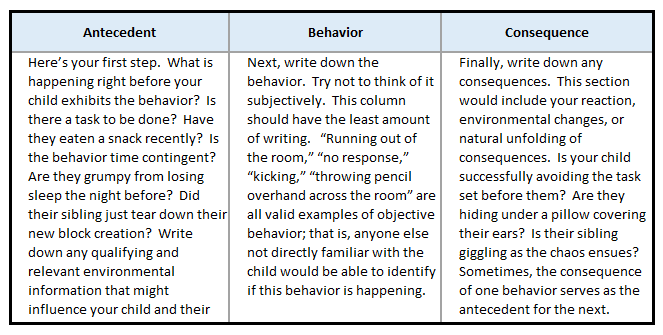Managing Difficult Behavior in Your Young Child
May 13, 2021
Behavior analysts define the meaning behind any behavior is called the function of the behavior. A baby may cry for different reasons, but the difference in understanding if they are hungry or hurt results from analyzing body language, assessing the environment, and using your parental intuitions. Trying to assess which need your child is attempting to communicate to you can help you discover appropriate functional replacement behaviors, coping skills, and preventative strategies.
The four most typical domains from which behavior originates are summarized below. Be sure to rule out any potential medical issues that may be influencing behavior. You can also read expert's advice for parents.
Need 1: Sensory input
This need is related to seeking sensory input or stimulation. Sensory-seeking behaviors can occur at any time. Sometimes, this can look like non-compliance.
How to serve this need: If the behavior is problematic (such as putting non-edible objects in the mouth), replace the behavior with a functional one, such as chewing gum or providing a sport-top water bottle to drink from.
Need 2: Escape task or environment
Behaviors in this category originate from a need to avoid or escape a task or when the environment is overstimulating. Avoidance of non-preferred conditions can be motivating; even as adults, we experience this.
How to serve this need: Prepare your child for success by providing clear, explicit expectations for behavior ahead of time, especially for events or locations that you know may trigger negative behavior. Prepping your child with the day’s schedule or expectations allows them time to process and plan how to regulate their own behavior.
Need 3: Acquire attention
Many of us might remember a classmate in school who was constantly blurting or making funny noises to get a reaction from the teacher. This need arises from a need for acknowledgment, respect, and understanding. Some children may notice they receive more attention from adults or peers through maladaptive behaviors. These attention-seeking behaviors can be embarrassing and disruptive for parents and guardians. If this aspiration confuses you, you may be a young parent, try reading the blog for young parents.
How to serve this need: Give your child as much positive praise and gestures when displaying positive behaviors.
Need 4: Acquire tangible item or activity
Any behavior from this domain allows access to some kind of tangible item, whether it is food, toys, or some other preferred object or activity. This wanted item may or may not be provided by another person.
How to serve this need: Create a token system (earning stars or stickers) or opportunities for your child to gain these items in a structured, meaningful way. Give immediate verbal praise when they have completed their task or hit their goal within their token system.
It can sometimes be difficult for parents to analyze behaviors. Looking at a behavior objectively without getting emotionally involved is a skill that parents can improve with practice. If the behavior is exhibited around only one parent, try to have the other parent discretely observe an incident or even take a video recording of the events. The events before, during, and after a negative behavior are the three key areas, a parent should analyze to help determine why their child is showcasing that particular behavior. Just think of it as “A.B.C.,” antecedent (events directly before the behavior), behavior, and consequence. Create a visual for yourself and create three columns to write down information.
Use these steps to analyze each individual behavior separately. Some behaviors may exhibit in the same way but can be used as different functions by the child. An example of this may be a child who runs away when they’ve been asked to clean up toys (avoidance), but this same child may run away when exposed to loud noises (sensory integration issues), and so it’s important to carefully determine why so that you can apply the appropriate strategies. Determine what might be the best functional solution as a replacement to the need your child is trying to communicate to you.
Specific Behaviors and De-escalation Strategies
Do not discount the benefits behind distraction and redirection. They can often be used as a way to avoid emotional upset and a way to address difficult situations or tasks at a later time. As a parent, try not to get hung up on needing a specific task done at a particular time. If it can be done later when your child is calmer, choose the path of least resistance, and you will both be happier. Avoid power struggles. Be sure to make it clear that the task is expected to be finished when they are less upset.

Avoiding tasks and non-compliance
Be sure to praise your child when they are following directions or completing the task you have asked them to do. Gently maintain your demand and avoid allowing them to move onto another task. This does not mean they need to complete the task as when you originally asked them. Part of modeling flexibility to our children is to offer flexibility ourselves. Be open to breaking the task into smaller, manageable chunks, offer to help, or allow them some type of control over their task. Give choices when your child is having a difficult time with a task you have requested of them. Give them the ability to choose the location, timing, or materials. “Would you like to brush your teeth on your special stool, or would you like to watch brushing them in the big mirror?” or “Would you like to help you with your homework before or after dinner?” Sometimes your child may join you if you start the activity first. They may not realize how fun it may be to do it together with Mom or Dad!
Tantrum or screaming
If your child possesses a language processing disorder or Autism Spectrum Disorder, avoid using language to solve their problem. Cognitive awareness of verbal language is reduced when emotions are heightened and using too much language can often exacerbate the conflict. Clear, simple, and short instructions, along with your support, can help calm things down. Try engaging in some self-regulating and calming behaviors to model appropriate coping skills. Deep breathing, yoga, and playing with playdough are great non-verbal calming activities.
Physical aggression, throwing items, or destructing property
Use limited language during these events. Watch your body language – and this point will serve for other potentially dangerous behaviors, such as physical aggression and destructing property. Prolonged eye contact, an overbearing stance, and other passively aggressive body language gestures can mean the difference between escalating or de-escalating already heightened emotions. Try to kneel at their level and move your body so you face side-by-side rather than face each other. This can help foster the feeling that you are not “against” them but working together to find a solution for their emotional upset.
Running away
If you can help it and they are not in danger, avoid chasing after your child. Following in pursuit often creates a fun game of chase. Setting up the environment as a safe, enclosed space will allow you to prevent elopement as much as possible. Make sure you are also offering physical options to engage in within this space, such as an indoor trampoline, crash pad, or yoga ball. Providing active and hands-on opportunities for children to “work through” difficulties in a safe space will encourage healthy coping skills.
About the author
United States, CA, Felton
Links and references
- https://freespiritpublishingblog.com/2017/11/30/anger-management-for-kids-with-autism-spectrum-disorders/
- https://cornerstoneautismcenter.com/aba-therapy/aba-101-the-functions-of-behavior/
- https://childmind.org/article/managing-problem-behavior-at-home/
- https://www.thoughtco.com/get-a-handle-on-behavior-3110692
- https://aimclinics.com/resources/six-tips-to-prevent-elopement-and-wandering







.jpg)









